| Columns Retired Columns & Blogs |
McCormack Line Drive TLC-1 preamplifier Measurements
Sidebar 3: Measurements
The TLC-1's measured gain was actually a little less than unity, at -0.15dB. Its input impedance was a moderate 12.25k ohms with the volume control set to its maximum position, while the source impedance from the buffered outputs was a whisker under 70 ohms. The buffered tape outputs featured a 101 ohm impedance, while from the passive main outputs, the source impedance varied from 26 ohms with the volume control set at its maximum position, to around 1700 ohms with it set to 12:00 (when the gain is approximately -16dB). DC offsets were unmeasurable, and the TLC-1 was non-inverting.
The McCormack offers an astonishingly flat response over a wide band. Fig.1 reveals the ultrasonic response from the buffered outputs to be down just 0.25dB at 200kHz, this not affected by the load. The channel separation (fig.2) is excellent, any crosstalk being buried in noise below 1kHz. Above that frequency is the usual 6dB/octave rise due to capacitative coupling between the channels, most probably across the volume and balance controls. There's a little more bleed from right to left than in the other direction, but the separation is still better than 80dB at 20kHz.
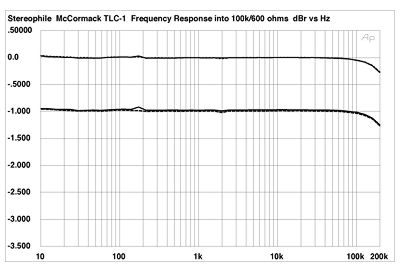
Fig.1 McCormack TLC-1, frequency response with v/c at maximum into 100k ohms (top) and 600 ohms (bottom) (right channel dashed, 0.5dB/vertical div.).
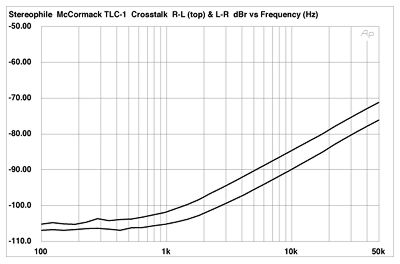
Fig.2 McCormack TLC-1, crosstalk with undriven input shorted, R-L top, L-R bottom (10dB/vertical div.).
The McCormack's active output stage is fundamentally very linear, its THD+noise level (fig.3) remaining below -100dB (0.001%) over most of the audio band with a 1V input level. As can be seen from this graph, however, reducing the load from a high 100k ohms to 600 ohms brings up the distortion to -70dB (0.03%). This can also be seen in the plot of THD+noise vs output voltage (fig.4). Although the clipping point (defined as the 1% distortion voltage) is approximately the same into both high and low impedances, at approximately 12.5V, the distortion rose rapidly at lower output levels into 600 ohms, at 2V reaching -60dB, or 0.1%.
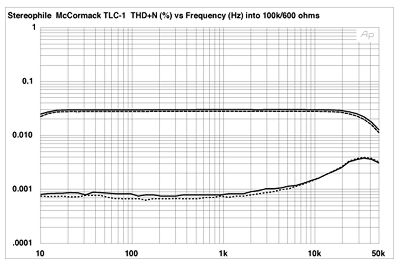
Fig.3 McCormack TLC-1, THD+noise vs frequency (from top to bottom): line stage at 1V output into 600 ohms (top) and 100k ohms (bottom) (right channel dashed).
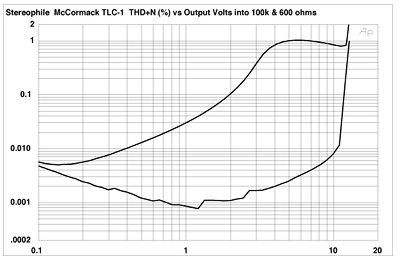
Fig.4 McCormack TLC-1, distortion vs output voltage into (from bottom to top): 100k ohms, 600 ohms.
The level of distortion is not the only thing that's important; so is its spectrum, the ear being much more sensitive to the presence of higher harmonics than to lower. Fig.5 shows the spectrum of the TLC-1 driving 50Hz at 1V RMS into 100k ohms. What distortion there is appears to be odd-order, with the third, fifth, seventh, ninth, and eleventh all visible. As nearly all these are more than 100dB below the level of the fundamental, however, I feel they will be completely inconsequential, subjectively. Into the 600 ohm load (fig.6), the third harmonic rises to -78dB, but, more importantly, the second harmonic at 100Hz makes an appearance, at -72dB (0.04%). Though the TLC-1 is best used into loads above 5k ohms, therefore, figs.4-6 suggest that it will just tend to sound a bit "fatter" at high levels into lower loads, due to the predominantly second-order distortion.

Fig.5 McCormack TLC-1, spectrum of 50Hz sinewave, DC-1kHz, at 1V into 100k ohms (linear frequency scale). Note that the third harmonic at 150Hz lies 98.3dB below the level of the 50Hz fundamental (0.0011%).
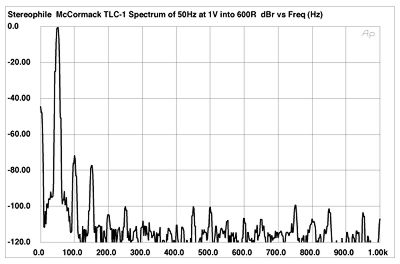
Fig.6 McCormack TLC-1, spectrum of 50Hz sinewave, DC-1kHz, at 1V into 600 ohms (linear frequency scale). Note that the second and third harmonics, at 100Hz and 150Hz, are the highest in level, 71.6dB and 77.3dB below the level of the 50Hz fundamental (0.025% and 0.015%, respectively).
Finally, I mentioned in my listening notes just how quiet a background the McCormack offered. Its unweighted, audio-band S/N ratios, with the volume control full-up but the inputs short-circuited, were 108dB (left channel) and 112dB (right), both figures referenced to a 1V output level. Fig.7 shows the low-frequency spectrum of that noise on a much-expanded vertical scale. I'm not sure why the components above 300Hz exist—they might be due to computational or analyzer quantizing errors—but the 60Hz AC-supply component and its second and third harmonics at 120Hz and 180Hz are well down in level, at -118dB, -129dB, and -126dB, respectively.
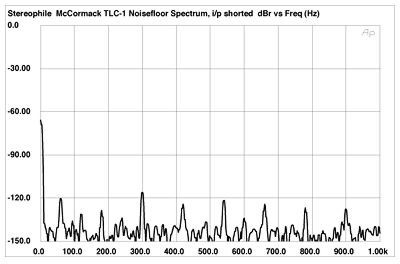
Fig.7 McCormack TLC-1, spectrum of background noise with volume control full-up and input shorted, DC-1kHz, ref. 1V into 100k ohms (linear frequency scale). Note that the power-supply components at 60Hz, 120Hz, and 180Hz lie at -118dB, -129dB, and -126dB, respectively.
It's becoming fashionable to refer to an amplifier's noise performance as if it were a digital component, allocating one "bit" for every 6dB of the ratio between the maximum operating level and the level of the noise and distortion artifacts. A direct connection between the component's noise floor and its ability to preserve the resolution of the audio signal passing through it can therefore be seen. A "16-bit" component's noise, crosstalk, and distortion spuriae will lie at the -96dB level; it will thus not degrade the resolution of a CD (assuming that the recorded data offer full 16-bit resolution, which is only rarely the case).
Referred to the CD system's nominal 2V output level, the TLC-1 offers "18-bit" resolution over much of the audio band, due to its S/N ratio of at least 114dB, what crosstalk there is being buried below the noise below 1kHz, and distortion of better than -102dB. This will be partly due to the fact that it doesn't have any gain. However, it does suggest that McCormack's design team knows a lot about device selection and matching, power-supply implementation, and printed-circuit-board layout.—John Atkinson
- Log in or register to post comments




































